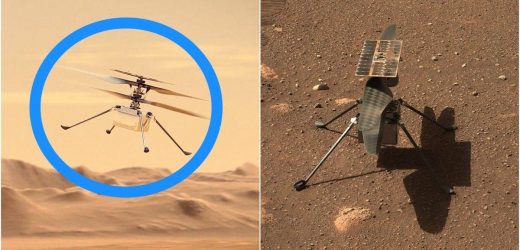- NASA’s Ingenuity helicopter failed to lift off of Mars for its fourth flight on Thursday.
- A software issue may have prevented the helicopter’s flight computer from transitioning to flight mode.
- Ingenuity has just a week left for the two final flights that will push it to the limit.
- See more stories on Insider’s business page.
NASA’s Ingenuity Mars helicopter was scheduled to embark on its most daring flight yet on Thursday. But it failed to lift off.
Ingenuity made history when flew for the first time on April 19 — a 10-foot hover that marked the first controlled, powered flight ever conducted on another planet. Since then, the 4-pound drone has completed two more flights, venturing further and flying faster each time.
Ingenuity was in good shape after its last flight, in which it traveled roughly 330 feet out and back. It was set to attempt an even more ambitious adventure on Thursday: A 117-second flight in which the little drone was supposed to reach a record speed of 3.5 meters per second. The plan was for the helicopter to climb 16 feet into the air, fly south for around 436 feet, and snap photos of the Martian surface along the way. It was then supposed to hover for more photos, turn around, and fly back to its original spot for landing.
But Ingenuity’s rotor blades didn’t lift it up at all.
NASA engineers are assessing the data, since it’s not yet clear what caused the failure. One potential cause is a software issue that first showed up during a high-speed spin test ahead of the chopper’s first flight. That test failed because Ingenuity’s flight computer was unable to transition from “pre-flight” to “flight” mode. Within a few days, though, NASA engineers resolved the issue with a quick software rewrite.
But those engineers determined that their fix would only successfully transition the helicopter into flight mode 85% of the time. So Thursday’s attempt may have fallen into the 15% of instances in which it doesn’t work.
If the helicopter is still in good shape, the Ingenuity team will probably try to fly again within a few days. They have just one more week to complete the two planned flights that would push the chopper to its limits. By the fifth and final flight, Ingenuity’s controllers plan to push the helicopter as far and fast as it can go. In the process, they expect Ingenuity to crash.
“We really want to push the rotorcraft flights to the limit and really learn and get information back from that,” MiMi Aung, the project manager for Ingenuity, said in a press briefing last week.
“That information is extremely important,” she added. “This is a pathfinder. This is about, you know, finding if there any ‘unknown unknowns’ that we can’t model. And we really want to know what the limits are. So we will be pushing the limits, very deliberately.”
NASA’s space-drone dreams
Ingenuity’s flights are experimental, meant simply to test what rotorcraft technology can do on Mars. So NASA expected that some of the attempts might fail. It’s all in the interest of gathering data to inform the development of future interplanetary helicopter missions, which could do all kinds of science and exploration that a rover can’t.
“We are aware that failure is more likely in this kind of scenario, and we’re comfortable with it because of the upside potential that success has,” NASA Associate Administrator Thomas Zurbuchen told Insider.
Space helicopters similar to Ingenuity could someday explore canyons and mountains, study large regions faster than a rover can, or even do reconnaissance for future astronauts.
Such space drones could fly “over ravines, down canyons, up mountains,” Josh Ravich, mechanical lead for the Ingenuity team at NASA’s Jet Propulsion Laboratory, told Insider. “Even rocky terrain is fairly inaccessible to the rovers but much more easily accessed by a rotorcraft.”
NASA already has one helicopter mission in development: A rotorcraft called Dragonfly is set to launch toward Saturn’s moon Titan in 2027. It aims to investigate whether that methane-rich world could host alien life.
Source: Read Full Article


